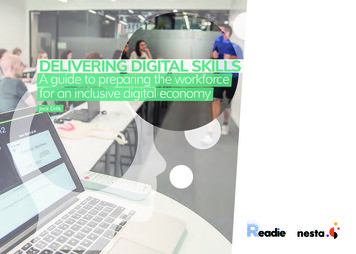
Transcription
DELIVERING DIGITAL SKILLSA guide to preparing the workforcefor an inclusive digital economyJack Orlik
Contents2
About this guide 4IntroductionWhy governments should address the need for digital skills7Five barriers to upskilling the workforce for digitalisation12Nine steps to an inclusive and responsive learning ecosystem14Digital skills provision in practice: Examples from around the world16The Additional Qualifications for Digital Competences Programme18Digilyft Kickstart20General Assembly 22Good Things Foundation 24Google Digital Garage26Grande École Du Numérique28SkillsFuture Singapore30Skills Plus32Social Builder 34Unionlearn 36Conclusion: What we’re doing next and how you can get involved38Methodology, bibliography and acknowledgements403
About this guideWho is this guide for?PolicymakersAround the world, governments have begun to recognise the urgentneed for adults to have better access to learning throughout theircareers to ensure that they don’t get left behind, and are able toreap the rewards of digitalisation.This guide has been created to help policymakers who have beentasked with finding ways to upskill the workforce.How can this guide help you?You’ll be inspired by existing initiativesThis guide includes ten case studies from around the world thathave been designed and implemented to provide digital skills toadults. Each one contains insights that can be used to address yourown policy challenge.It will help you to plan your policy or programmeBy identifying the key elements of an inclusive and responsive skillsecosystem, we provide a checklist of areas to explore and addresswhen designing policy for digital skills.It gives you a framework to guide your collaborationwith stakeholdersYou can use the framework in this guide to identify who you mightpartner with to deliver key services which support upskilling andreskilling.4
In this guide, you’ll discover Five barriers to upskilling the workforce - pg 12The challenges you need to keep in mind whendesigning policy.Nine steps to an inclusive and responsive skillsecosystem - pg 14The components you should combine and support tomake sure the right skills are taught to the right people,in the right way.Initiatives that have already helped people to learndigital skills - pg 16Case studies of policies and programmes whichhighlight effective approaches that support upskillingand reskilling.Valuable resources for further reading,indicated by this symbol -5
Introduction6
Why governments should addressthe need for digital skillsYou have undoubtedly experiencedthe benefits of rapid digitalisationIn business and the economy, digitaltransformation promises numerous rewardsThe internet, which less than two decades ago was accessible onlythrough the slow process of wiring and firing up a 52Kbps dial-upmodem, is now frequently wireless, always connected and lightningfast.The use of digital tools within workplaces has been shown toincrease productivity, catalyse innovation, and improve the livesof workers.3This high-speed development has touched the lives of people acrossthe planet. Globally, it is estimated that ‘nearly half of the world’spopulation (that is, 3.7 billion people) make use of the internet’.1The capacity of digital tools to enhance our lives has led the internetto become the primary medium through which many of us readnews, communicate with friends and colleagues, manage ourfinances, organise our travel, share our photographs, go shopping,submit our tax returns – and so on.2We have seen how digital technologies can be usedto launch global companies, grow incumbent firms, and createdemand for new roles, such as data scientists and artificialintelligence specialists.Looking forward, the development of Industry 4.0 holds the promiseof more precise manufacturing, less strenuous working conditions,and increased efficiency.4For governments wishing to steer their countries towards aprosperous future, digitalisation represents a valuable opportunityfor society and the economy.Szabó, F. (2017) ‘Readie explainer: Industry 4.0’UNESCO Broadband Commission (2017) ‘Working groupon education: digital skills for life and work.’7
But the benefits of digital transformation areaccompanied by urgent challengesThe term ‘transformation’ itself articulates a key issue: thecontinuous development of digital technology is changing the worldquickly, often in dramatic and unexpected ways.New problems frequently emerge as a result of digitalisation, andexisting inequalities are being intensified.5These include the well-publicised challenges to jobs and thelabour market. Following Osborne and Frey’s seminal 2013paper, ‘The future of employment: how susceptible are jobs tocomputerisation?’6many reports have described the pressingthreats that digitalisation and automation present to existing labourmarkets, and predicted that the world of work is set to experienceseismic shifts.7Since even conservative projections anticipate that automation willhave wide-ranging and potentially rapid effects on jobs, it is clearthat governments should act now to foster a digital economy that isinclusive, humane, and supported by appropriately skilled workers.8
The supply of digitalskills is lagging farbehind demandWorkplaces need skilled workers to survive in aconstantly changing digital environmentIf businesses and organisations cannot keep up with technologicaldevelopment, they risk losing customers and revenue to digitallyempowered competitors. To drive growth and remain resilient,employers need workers who can use digital tools efficiently andcreatively, and adjust to the accelerated pace of change thataccompanies persistent innovation.8The demand for ICT specialists, such as data scientists and webdevelopers, is therefore growing in organisations both within andoutside of the technology sector. These occupations are forming acore part of the economies of the future.9Yet ICT specialists are not the only workers who need digital skills.Whatever their role, people need to update their skills to deal withthe wide-ranging transformations brought about by digitalisation.10Frey, C.B. and Osborne, M.A. (2013) ‘The Future of Employment:How susceptible are jobs to computerisation?’38%of workplaces in Europereport that a lack ofdigital skills is harmingtheir business.1140%of employers claim thatthey struggle to findcandidates for ICT roles.1240%of people who use softwareat work do not know howto do so effectively.13Schneider, P., Bakhshi, H. and Armstrong, H. (2017) ‘The Futureof Skills: Trends impacting on US and UK employment in 2030.’9
People who do not adapt to the dynamic demandsof digitalisation will be left behindTechnological advancements will continue to change the worldof work in ways that are not easy to predict. To keep up with andbenefit from the opportunities that digitalisation offers, we all needto upskill throughout our careers.14Job displacement arising fromautomation will mean that many people need to completely reskillto find a new role.15Some of the skills we will need to learn are technical, but it isimportant to note that people also require other ‘soft’ competencies,such as collaborative problem solving and a learning mindset, tothrive in a digital environment and complement the capabilities ofcomputers.16Those that don’t learn new skills face exclusion from the workforce:according to one recent survey, over half of people with no ICTexperience are now unemployed.17Carretero Gomez, S., Vuorikari, R. and Punie, Y. (2017) ‘DigComp2.1: The Digital Competence Framework forCitizens with eight proficiency levels and examples of use.’Bakhshi, H., Downing, J., Osborne, M. and Schneider, P. (2017).‘The Future of Skills: Employment in 2030.’Mulgan, G. (2016) ‘Adult education will move fromthe bottom to the top of the policy agenda in 2017.’10DefinitionsUpskilling means the process through which anindividual learns the skills to adapt to their currentrole as it is transformed. As digitalisation continuesto change the work environment and economy,everybody will need to upskill frequently.Reskilling refers to the process of preparationfor work in a new role. People who do this willstill need upskilling opportunities throughout theircareers, as these new roles will also be subjectto digital transformation.
Governments need to make sure that theircountry’s workforce has the right skills tocontribute to the evolving digital economyIf citizens don’t develop the competencies they need to work ina continuously changing digital environment, countries risk highunemployment, increased inequality, and reduced growth.Around the world, governments, NGOs and businesses have begunto recognise that adults need better access to learning throughouttheir careers.18Through a variety of programmes, and often in collaboration, theyare delivering services and interventions which support people inwork to upskill and reskill as digital transformation progresses.Drawing insights from initiatives around the world, this reportprovides a guide to the key steps needed to upskill and reskillworkforces for digitalisation.OECD (2016) ‘Ministerial Declarationon the Digital Economy (“CancúnDeclaration”).’11
Five barriers to upskillingthe workforce for digitalisationPolicy must address five common barriersto learningIn an ideal world, businesses and individuals would recognisethe importance of new skills, and have the resources to prioritisecontinuous learning.In reality, governments need to overcome a number of obstaclesif they are to foster a digitally skilled workforce.Taking a broad view, Readie has identified five barriers that policyteams are likely to encounter as they design and implement policiesto improve the provision of learning for adults in work.12
FIVE BARRIERS TO UPSKLLING THE WORKFORCE FOR DIGITALISATIONCulture of learningPeople think that learningis for the youngMotivationPeople don’t see a needfor digital skillsLeadershipOrganisations’ leadersneed to drive digitaltransformationResourcesLearning puts pressureon the resourcesof businesses andindividualsAccess to trainingPeople can’t find trainingthat is relevant to theirneedsTraditionally, mostlearning has taken placein the early part of aperson’s life. With thechanging demands ofcontinuous technologicaldevelopment, however,individuals now need totake time to update theirskills throughout theirlives.19 In many societies,this will require a shift inthe culture of work andlearning.Many people, from storemanagers to deliverydrivers, do not see aneed to learn new skills,despite the opportunitiesthey afford. Accordingto OECD analysis, thislack of awareness aboutthe need for training isparticularly acute amongworkers in occupationsthat are very likelyto experience largechanges as a result ofdigitalisation.20In order to prioritise thelearning and use of digitalskills, organisations oftenneed to reform many oftheir processes. Thesechanges require strongleadership and cleardirection from those atthe top.21Firms are organised toprioritise the delivery ofgoods and services inresponse to demand, andcan struggle to divertresources to upskill theirstaff.22Individuals and employersoften need support toidentify the courses whichare relevant to them.To become motivatedto invest in upskilling,individuals andbusinesses need torecognise the benefitsof learning the skills toadapt for digitalisation,and understand the risksof holding back.Harvard BusinessReview (2017)‘Inside GE’sTransformation’If they are not supportedby their employers orothers, individuals arelikely to lack the time andmoney to take part intraining outside of work.To meet the demand fortraining, effective coursesmust be available thatteach appropriate skillsand are easy to access.13
What governments can do:nine steps to an inclusive andresponsive learning ecosystemTo develop a digitally skilled workforce,governments should facilitate learning ecosystemsfor people in work that: Identify the skills they need Address the barriers that inhibitthem from upskilling Help them to adapt to continuous changeWe have identified nine elements that are crucial to such a system.In practice, governments or individual organisations do not need todeliver all of these elements alone. The case studies in this guideshow how public and private stakeholders often work together tocreate dynamic learning systems that are inclusive and responsiveto changes to jobs.In such partnerships, governments can use their powers to setstandards and targets, coordinate collaboration and informationsharing, ensure that programmes are properly evaluated, andidentify where further funding and investment should be focused.14
NINE STEPS TO AN INCLUSIVE AND RESPONSIVE LEARNING ECOSYSTEMTeams wishing to foster the development of a digitally skilled workforce can use thisframework as a checklist to plan policy for skills provision. The framework may alsobe used as a tool to discover gaps in the current learning system, and to identify otherteams and organisations with whom it may be effective to collaborate.LABOUR MARKET FITSKILLSFORECASTINGCURRICULUMDEVELOPMENTSKILLS FORECASTINGTo make sure that everyindividual learns skills thatare relevant and useful,those designing curriculaand delivering training needto forecast skill demandsthrough up-to-date labourmarket data.CURRICULUMDEVELOPMENTThe rate of change fordigital technology and theskills individuals requiremeans that curricula shouldbe regularly evaluated andupdated.DELIVERY SUPPORTLEARNER RTCAREER PASSPORTTRAININGDELIVERYPATHWAY GUIDANCEPeople need help to find andchoose high quality trainingthat fits with their careeraspirations and the needsof the labour market.FUNDINGLearning puts a strain on the alreadypressured resources of individuals andbusinesses. Many will need financial supportor incentives to undertake and completetraining.ASSESSMENTDifferent people
The use of digital tools within workplaces has been shown to increase productivity, catalyse innovation, and improve the lives of workers.3 We have seen how digital











